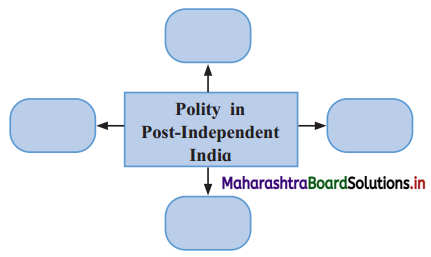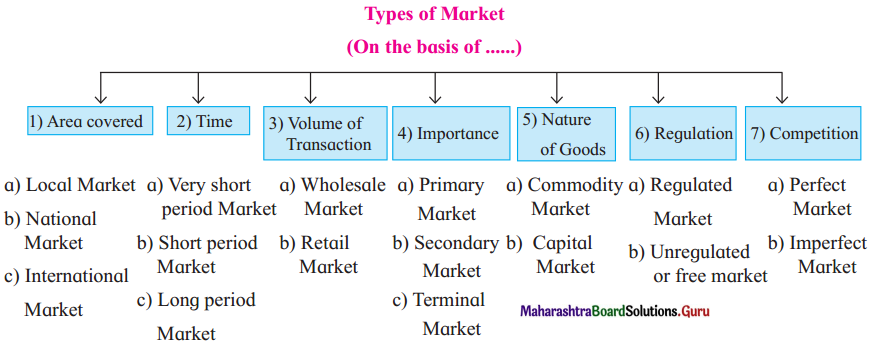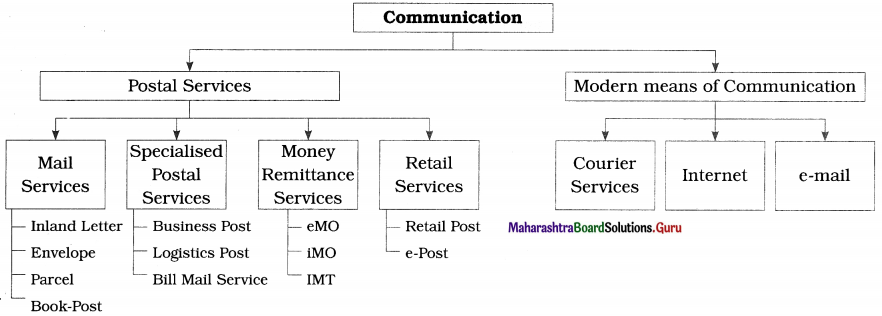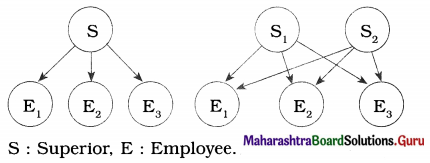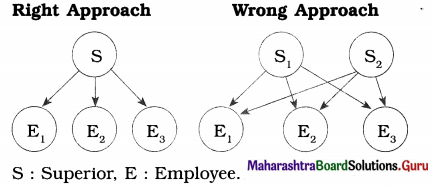Balbharti Maharashtra State Board Class 12 Sociology Solutions Chapter 2 Segments of Indian Society Textbook Exercise Questions and Answers.
Maharashtra State Board Class 12 Sociology Solutions Chapter 2 Segments of Indian Society
1A. Complete the following statements by choosing the correct alternative given in the brackets and rewrite it.
Question 1.
Secondary type relations are significant in ___________ community. (rural, tribal, urban)
Answer:
urban
![]()
Question 2.
Over 55% of the tribal population in India is found in the ___________ region of the country. (Western, Central, Southern)
Answer:
central
1B. Correct the incorrect pair and rewrite it.
Question 1.
(a) Landlord – Zamindar
(b) Initiative for rural development programme – Community Development Programme
(c) Three-tier system of governance – Integrated Rural Development Programme
(d) Primary occupations – Traditional societies
Answer:
(c) Three-tier system of governance – The village panchayat
1C. Identify the appropriate term from the given options in the box and rewrite it against the given statement.
Urban society, Devrai, Gramdevata
Question 1.
Sacred groves in the tribal community.
Answer:
Devrai
Question 2.
Instances of white-collar crime.
Answer:
Urban society
1D. Correct underlined words and complete the statement.
Question 1.
Individual status in urban society is mostly ascribed.
Answer:
Individual status in urban society is mostly achieved.
Question 2.
The custom of worshipping non-living bodies is called animism.
Answer:
The custom of worshipping non-living bodies is called animatism.
2. Write short notes.
Question 1.
Problems of the tribal community.
Answer:
Problems faced by the tribal community:
Alienation from forest land: Many tribes engage in primary agriculture, food-gathering and hunting hence they are heavily dependent on the produce of the forest. Therefore, when outsiders exploit the tribal land and its resources, the natural eco-cycle and the tribal life dependent on it is greatly disturbed. Industrialization and construction of water reservoirs resulted in the further acquisition of land by the State.
Bonded labour: Though Bonded labour is banned by Indian Law, it still prevails in some tribal areas. Bonded labour is considered to be a serious problem, which started due to rampant poverty and lack of stable income among the tribals. In fact, land alienation, indebtedness, bonded labour, and poverty are problems that exist hand-in-hand. However, due to the efforts of the government and voluntary organizations, many tribals are being freed from this problem.
![]()
Shifting cultivation: Shifting cultivation among tribals is a problem since it involves large-scale deforestation and soil erosion. Shifting cultivation is known by various names such as Jhum, Khallu, and Podu.
Illiteracy: Illiteracy among tribal is a major hindrance towards their development. School hours often clash with agricultural and wage-earning activities of children. Children are looked upon as economic assets and are thus expected to supplement their parents’ income Also, schools are often not located in the vicinity of tribal settlements. The formal courses in schools are not taught in tribal languages, so children lose interest in learning, leading to a high dropout rate.
Question 2.
Characteristics of urban community.
Answer:
Urban community includes towns, cities, and metros with their different way of life.
Urban communities have the following characteristics:
Heterogeneity: In urban areas, you will find people belonging to diverse groups as there is continuous migration from tribal and rural areas as people come in search of employment, education, healthcare, and the hope of raising their standard of living.
The high density of population: Cities and towns have a higher density of population due to the large population and also because of a steady influx of people pouring into urban centers.
Different occupations: Occupations are more specialized, as there is a widespread division of labour and specializations.
Secondary relations: In urban areas, interaction among people is not personal rather characterized by formal interactions and impersonal relationships which are based on vested interests.
3. Write differences.
Question 1.
Rural Economy and Urban Economy.
Answer:
| Rural economy | Urban economy |
| (i) Occupation: The main occupation of the rural community is agriculture which is in a state of backwardness. | (i) Occupation: The occupation in urban areas is mainly non-agricultural, i.e. based on manufacturing, trade and commerce, professional and governance, services, etc. |
| (ii) Technology: Rural economy is dependent on the use of plough, animal power, seeds, fertilizers for agricultural activities. | (ii) Technology: The urban economy is dependent on advanced technology and up-to-date machinery for economic activities. |
| (iii) Division of Labour: There is less scope for division of labour and specializations in rural communities. | (iii) Division of Labour: Occupations are more specialized and based on the division of labour. |
| (iv) Markets: Rural weekly market is the main economic institution as rural economy is associated with various crafts like pottery, carpentry, etc. | (iv) Markets: Marketisation is an essential feature of urban centers today – E-marketing, E-biz, etc. |
| (v) Nature of Employment: Unemployment such as educated, total unemployment seasonal unemployment, underemployment are found in the rural community. | (v) Nature of Employment: All types of unemployment like literate, illiterate, skilled unemployment, unskilled unemployment are found in cities. |
| (vi) Dependence on Nature: Rural economy depends upon natural factors like a monsoon for agriculture. | (vi) Dependence on Nature: The problem of unemployment has intensified other problems like poverty, malnutrition, beggary, prostitution, etc. |
Question 2.
Tribal Community and Urban Community.
Answer:
| Tribal Community | Urban Community |
| (i) Size: According to in 2011 census, the tribal population constitutes about 8.6 percent of the total population. | (i) Size: According to the 2011 Census, 31% of the population lives in urban agglomerations/towns. |
| (ii) Density of Population: They are located in remote forests and hilly areas and the density of population is low. | (ii) Density of Population: An urban area is a human settlement with a high population density. |
| (iii) Occupation: They are engaged in varied occupations such as hunting, fishing, and food gathering of forest produce, basket making, weaving, iron-smith, etc. | (iii) Occupation: The occupation in urban areas is mainly non-agricultural, i.e. based on manufacturing, trade and commerce, professional and governance, services, etc. |
| (iv) Nature of Social Control: In tribal communities informal means of social control like Customs, traditions, religion, magic are effective social control mechanisms. | (iv) Nature of Social Control: In urban community formal means of social control like laws, police, court, maintain law and order. |
| (v) Way of Life: Tribal community has its own culture i.e common way of life, they share common behavior patterns dialect traditions, norms, and values. | (v) Way of Life: Urban community consists of people coming from different socio-cultural backgrounds belonging to different religions, caste, languages, etc, hence wide difference is found in the ways of living of urban people. |
4. Explain the following concepts with examples.
Question 1.
Urban crime
Answer:
Urban crime: The problem of crime increases with the growth in urbanization.
The problem of urban crime is becoming more complicated in the present-day world because criminals often get protection from politicians, bureaucrats, and other urban elite.
Some criminals reach high political positions by using their money and muscle power. In fact, the increasing trend in urban crimes leads to much tension and insecurity which makes city life unsafe.
![]()
Not only the poor, deprived and slum dwellers take to crime; people from well-to-do families also resort to crime in order to make a fast buck and to meet cravings for a lavish life occasional failure in life also may drag youngsters to crime.
Examples: Violent urban crimes like abuse, rape, murder, kidnapping, cybercrime, economic offenses, and various forms of white-collar crime are rampant in many large cities.
Question 2.
Sacred groves
Answer:
Sacred groves:
Sacred groves are an integral part of tribal society. Sacred Groves are tracts of forest land dedicated to local deities who are manifestations of the energy of the universe. Since hunter-gatherer times, the tribal and rural people of India have been revering the ‘Earth-Energy’ and the ‘Cosmic-Forces’ manifested in the forests and the groves.
These deities are believed by the tribal people to be fiercely protective about the grove and the village. Sacred Groves are like a separate institution through which a myriad of relationships spread, giving rise to a cultural pattern. This pattern connects the local people with their fields, forests, and with one another.
Worship in the sacred groves is related to fields, forests, and to the survival of the tribal and rural which in turn have helped to conserve biodiversity.
Examples: “Shedoba Cha Van” (Forest of Shedoba) Sacred Grove in Murbad Taluka, Dist. Thane.
The common examples of sacred groves are Ficus Religiosa (Peepal tree), Ficus benghalensis (Banyan tree).
Other examples of sacred groves in India include:
Pavithravana in Andhra Pradesh, Gumpa Forests attached to Buddhist monasteries in Arunachal Pradesh, Sarana in Jharkhand, Kavu, and Sara Kavu in Kerala and Devrai, Devrahati, and Devgudi groves in Maharashtra.
5A. Complete the concept map.
Question 1.
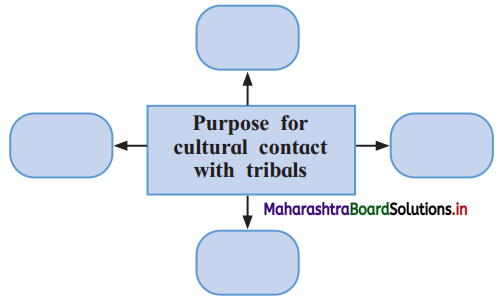
Answer:

5B. State whether the following statements are True or False with reasons.
Question 1.
Division of labour is complex in urban communities.
Answer:
This statement is True.
- A very clear and specialized division of labour is found in urban areas. People are trained for their job and skills according to institutional and professional requirements.
- One can find the division of labour and specialization in every walk of life such as industry, trade, education, etc.
- An interdependence of professions is observed in almost all fields of life.
- Every work is divided among the employees, on the basis of age, sex, educational qualification, training, talents, etc.
- For example, in the medical profession, there are gynecologists, radiologists, pediatricians, anesthetists, and physicians.
![]()
Question 2.
The traditional influence of caste has changed today.
Answer:
This statement is True.
- Today the traditional influence of caste has changed due to the impact of industrialization, urbanization, advanced means of transport and communication, the spread of modern education, constitutional provisions, social legislations, etc.
The restrictions of food habits of the Indian people have been relaxed. The distinction between touchable and untouchable is not felt in modern times. - The special civil and religious privileges enjoyed by the upper castes and disabilities by the lower castes have been removed by the constitutional provisions and social legislations.
- Occupations are becoming more and more caste-free. The people have greater choice to take up an occupation based on their skills, education, and aptitude.
- Inter-caste marriages have increased. The caste councils have disappeared and their authority has been transferred to the State.
- The traditional rights, authorities, and sanctions based on caste hierarchy may not be apparent today, however, it is so deeply entrenched in people’s minds that it permeates social interactions Nevertheless, in the ordinary transactions of daily life, village people tend to cooperate with each other.
6. Give your personal response.
Question 1.
Why is there a lack of community feeling in cities?
Answer:
In cities, people are more individualistic in their attitudes. They behave and live independently without taking into consideration the will of others. Even the neighbors are often found to be strangers. Means of modern communications such as telephone, radio, and internet are mostly used by the people in cities for personal contacts. The connections in cities today are more superficial, less meaningful. City life is characterized by the predominance of secondary contacts, impersonal, casual, and short-lived relations. Due to these reasons we often find a lack of community feeling in cities.
Question 2.
Explain the need for rural development.
Answer:
The rural economy is an example of an agrarian economy. Although farming and agriculture are some of the most important primary activities, the problem lies in the fact that they share in the GDP of the agriculture sector is on a constant decline. At the same time, about two-thirds of India’s population depends on agriculture. As a result, productivity is not up to the mark. Moreover, public investment declined since 1991 coupled with a lack of adequate infrastructure, credit, transport, unemployment, etc. Henceforth the agricultural output has grown at only 3.2% during 2007-2011. All these factors have been denting the process of development. Therefore there is a need to focus on rural development and not just urban development.
7. Answer the following question in detail. (About 150-200 words)
Question 1.
Traditional communities tend to hold on to their customs, traditions, and beliefs.’ Using examples of your own, explain the statement with special reference to either family or religion. Also, discuss any three ways by which change is introduced into traditional communities.
Answer:
Traditions customs and beliefs bind people together and build bonds between them. By sharing a sacred quality and worshipping together a ‘collective conscience emerges’ religion is not just a set of beliefs, it involved sacred rituals. It creates a single moral community that is collective. Religion legitimizes society’s values, customs, and traditions by making them sacred. Hence ‘Traditional communities tend to hold on to their customs, traditions, and beliefs.’
With reference to family
In India in a typical joint family, all members reside together in one house. They eat food prepared jointly; they hold common property. In the Indian family, the feeling of dependence and discipline is found on a large scale. The social-economic, religious and cultural life of Indian families is collective in nature. In the family of traditional communities, the members believe in one religion and they worship the same deities. Various religious rituals are jointly celebrated and all the members participate in them. All family members take part in the common worship, rituals, rites, and ceremonies. They are homogeneous in nature and everybody works for a common goal and welfare of all members.it provides shelter to all its members, including the weak, aged, and widows.
![]()
The change introduced into traditional communities
Due to the impact of various factors like industrialization, urbanization, advanced means of transport and communication, social legislation, the spread of modern education, democratic political system, changes are occurring in the structure and functions of traditional communities. Accordingly, the family in India has undergone significant changes. Due to the impact of industrialization and urbanization traditional joint family is replaced by the nuclear family. Due to urbanization social relationships have become more formal and contractual. Customs, traditions, values, rituals, beliefs have changed.
Today the size of the family is decreasing. The power of patriarchal authority has been declining. Various social legislations have provided individuals many rights. Besides, due to the impact of the spread of education, individualism, democratic values like liberty and equality, personal desires are becoming dominant. Though the head of the family is the husband, and he has to make decisions by taking into consideration the opinions and desires of his wife and children. Families or religion in the traditional communities was based on collectivity. Due to the impact of individualism, the importance of kinship is decreasing. The recreational function of the family is losing its importance because modern means of recreation have become popular.
Class 12 Sociology Chapter 2 Segments of Indian Society Intext Questions and Answers
Check your progress (Textbook Page No. 28)
Question 1.
Name one tribe in South India, Western India, and North-East region.
Answer:
- Tribe in South India – Toda, Kota.
- Western India – Bhil, Warli.
- North-East region – Garo, Khasi
Question 2.
Identify any three tribal occupations.
Answer:
- Hunting and fishing.
- Simple agriculture and shifting cultivation.
- Food gathering of forest products.
Question 3.
Give examples of tribal belief systems.
Answer:
Belief in black and white magic, ancestor worship, benevolent and malevolent spirits. Sacred Groves are an integral part of tribal society, a tract of forest land dedicated to local deities who are believed by the tribal people to be fiercely protective about the grove and the village.
Check your progress (Textbook Page No. 30)
Question 1.
Why are tribal people slow to change? Give two reasons.
Answer:
- Tribal people are slow to change because.
- Tribal practice simple occupations based on primitive technology. Most of the occupations fall into the primary categories such as hunting, gathering, and agriculture. There is no profit nor surplus making in such an economy.
- Illiteracy among tribal is a major hindrance to their development.
![]()
Question 2.
Identify three forms of tribal religion.
Answer:
- Animism: The custom of worshipping the soul or ancestors.
- Manaism: The custom of worshipping force which is believed to move swiftly across the world and enter into objects and people, giving them powers that they previously lacked.
- Naturism: The custom of worshipping elements of nature like river, stream, Sun, Moon, forest, etc.
Question 3.
State two problems caused by cultural contact with non-tribal people.
Answer:
The two problems caused by cultural contact with non-tribal people are:
- The exploitation of tribal resources, which were rich in minerals and natural resources.
- Alienation of tribals from their traditional medicine due to the entry of specialists like medical professionals, agents, and vendors into the tribal areas.
Check your progress (Textbook Page No. 35)
Question 1.
State three characteristics of the rural community.
Answer:
- The dominance of agriculture.
- Primary relations.
- Social homogeneity.
Question 2.
Enumerate three changes in rural communities.
Answer:
- The joint family was once upon a time a significant pillar of village organization, has diminished significantly.
- The traditional rights, authorities, and sanctions based on caste hierarchy is not apparent today in a rural community.
- Abolition of intermediaries such as the zamindari system.
Question 3.
Identify any three programmes started by the Government for rural development.
Answer:
- The Community Development Programme (CDP) was started in 1952.
- The Integrated Rural Development Programme (IRDP) replaced the CDP in 1979.
- Pradhan Mantri Gram Sadak Yojana.
Check your progress (Textbook Page No. 37)
Question 1.
State three characteristics of urban life.
Answer:
- Large-scale social mobility.
- Different occupations.
- The high density of population
![]()
Question 2.
Why are nuclear families more common in urban than rural communities?
Answer:
Nuclear families are more common in urban than rural communities due to individualism which has led to a significant increase in nuclear families. Family is less stable today. More than the family as a unit, it is the individual who is given more importance. Joint families are comparatively less in number, nuclear families are on the rise in the cities.
Question 3.
Why are secondary relationships a significant characteristic of urban areas?
Answer:
In urban areas, interaction among people is largely based on anonymity and secondary contact. It is not personal nor face-to-face, rather, cities are characterized by formal interactions and impersonal relationships which tend to become time-bound and based on vested interests.
Activity 1 (Textbook Page No. 25)
Question 1.
Form groups of five students. Refer to the geographical classification of tribes in India. Choose a tribe and prepare a PPT / or Chart Presentation of 8 – 10 slides of its cultural traits.
Answer:
Geographical Distribution of Indian Tribes: L. P. Vidyarthi (1977) has given a five-fold geographical classification of tribes in India on the basis of ecological, social, economic, administrative, ethnic, and racial.
| Region | Location | Names of Tribes |
| Himalayan Region | It has three sub-regions: (a) North-Eastern Himalayan region (b) Central Himalayan region (c) North-Western Himalayan region |
Garo, Khasi, Jainta, Naga, Mizo, Khasa, Lepcha, Gaddi |
| Middle Indian Region | Bihar, Jharkhand, West Bengal, Odisha, Madhya Pradesh, and Chhattisgarh. Over 55 percent of the tribal people of India live in this zone. | Gond, Santhal, Munda, Ho, Oraon, Birhor |
| Western-Indian Region | Rajasthan, Gujarat, Maharashtra, Goa, Dadra, and Nagar Haveli. It has about one crore tribal population. | Bhil, Katkari, Warli, Baina |
| South India Region | Andhra Pradesh, Telangana, Tamil Nadu, Karnataka and Kerala. About one-sixth of the tribal population of India is found in the Southern zone. | Toda, Kota, Irula, Badaga, Chenchu, Kurumba |
| The Island Region | The Islands of Andaman and Nicobar in the Bay of Bengal and Lakshadweep in the Arabian Sea. | Andamanese, Nicobarese, Onge, Jarawa, Sentinelese |
[Presentation to be done in the classroom by students.]
Activity 2 (Textbook Page No. 29)
Visit a tribal settlement in your region and document different aspects of their life (e.g., clothing, shifting cultivation, sacred groves). If a physical visit is not possible then take information from the internet. Make a short presentation to your class and follow it up with a discussion.
Answer:
Presentation to be done in the classroom by students.
Activity 3 (Textbook Page No. 30)
Find out about any tribal scheme started by the government or an NGG. Share your findings with your class.
Answer:
Scheme of strengthening education among Scheduled Tribe (ST) girls in low literacy districts.
Objective – The scheme aims to bridge the gap in literacy levels between the general female population and tribal women, through facilitating 100% enrolment of tribal girls in the identified districts or blocks, more particularly in Naxal affected areas and in areas inhabited by Primitive Tribal Groups (PTGs), and reducing drop-outs at the elementary level by creating the required ambiance for education. Improvement of the literacy rate of tribal girls is essential to enable them to participate effectively in and benefit from socio-economic development.
![]()
The scheme is implemented through Voluntary Organisations/Non-governmental Organisations (NGOs) and autonomous society/institutions of State Government/Union Territory Administration.
Activity 4 (Textbook Page No. 35)
Class Debate/Discussion:
‘The impact of caste on Indian society has reduced today’.
Answer:
After India attained independence in 1947, the country introduced laws to make discrimination against lower castes illegal and to improve their socioeconomic positions. As a result, some from the underprivileged groups have made it to leading positions, such as Dr. B. R. Ambedkar, who wrote the Indian constitution, and KR Narayanan, who was elected president in 1997.
Reservations were introduced for college admissions and jobs. The scenario within the country has undergone a lot of change with the progress in technology, education, social outlook, urbanization, and modernization. With the spread of urbanization and secular education, the influence of caste has decreased. This has occurred especially in cities where inter-caste marriages and people of different castes living reside in societies. However, despite the growing changes the caste identity still holds a lot of importance in society.
Activity 5 (Textbook Page No. 36)
Debate the positive and negative effects of heterogeneity in an urban setting.
Answer:
In urban areas, you will find people belonging to diverse groups such as class, occupation, caste, language, and religion, etc., all living in the same territory. There is continuous migration from tribal and rural areas as people come in search of employment, education, and healthcare and with the hope of raising their standard of living. Heterogeneity can be an advantage because it creates a cosmopolitan and tolerant approach, traditions, values, and customs helps to improve the social life of people as they learn about a new culture, customs, and languages which helps to improve brotherhood among people.
It can also create tensions, the ways of life of a city’s inhabitants are culturally differentiated and most cities have significant minority populations that are dominated by specific ethnic groups/cultures.
Activity 6 (Textbook Page No. 39)
In schools located in urban areas conduct a survey using a questionnaire or interview techniques, to understand problems in slum areas. Students from rural and tribal areas should do the same exercise on farmers’ problems. Write and present your report to the class.
Answer:
A survey or interview is to be conducted by students to understand problems in slum areas or tribal/rural farmer’s problems.
Sample of a questionnaire for the slum survey
- General Information
- Location
- No. of years you’ve been living here
- No. of earning members
- Total members in the family
- Education level of male adults
- Education level of female adults
- The monthly income of the family
- How often do the members fall in sick
- No. of elderly people (above 60 years)
- Principle occupation and industry of the adults.
![]()
Activity 7 (Textbook Page No. 40)
Gather information on various tribal, rural, and urban development programmes in your area. Present your findings to your class and follow them up with a discussion.
Answer:
(i) Urban Development Programmes
Pradhan Mantri Awas Yojana (Urban) or Housing for All by 2022 Mission:
The ‘Housing for All by 2022’ under the scheme of “Pradhan Mantri Awas Yojana — Housing for All (Urban)” launched by the Central Government aims to provide housing to all urban people by 2022. It provides central assistance to States and UTs for constructing houses to all eligible sections by concentrating on urban slums and economically weaker sections.
Swachh Bharat Mission (SBM):
A major associated urban development programme is making India’s urban centers clean. For this, the SBM targets to achieve 100 percent scientific management of municipal solid waste in 4041 statutory towns/ cities in the country by 2019.
(ii) Rural Development Programmes
The government assured to provide electricity and clean cooking facility to all willing rural families by 2022 under Ujjwala and Saubhagya Yojana.
Pradhan Mantri Awas Yojana – Gramin (PMAY-G) will provide 1.95 crore houses to eligible beneficiaries during its second phase (2019-20 to 2021-22) along with amenities like toilets, electricity, and LPG connections.
(iii) Tribal Development Programmes
On March 19, 2020, TRIFED, the Tribal Cooperative Marketing Development Federation of India launched the “Tech for Tribal” initiative. The initiative aims at providing entrepreneurship skills to the tribal people.
Pradhan Mantri Van Dhan Yojana It is an initiative that was launched in 2018. The Scheme aims to strengthen tribal producer companies. It was launched in 27 states.
Activity 8 (Textbook Page No. 42)
Visit a government primary or Ashram school in a tribal or rural or urban area. Find out from the school head about enrolment numbers, classes taught, the number of teachers, subjects they teach, problems they face, needs that they have. Write a report on your findings.
Answer:
[To be done by the student.]
General information:
There are a total number of 502 government Ashram schools under the tribal development department for the students belonging to socio-educationally backward tribal groups in the remote areas of the state. In order to provide quality education to the Scheduled Tribe students, the Central Government initiated “Ekalavya Residential Schools” on the basis of Navodaya Vidyalayas, through the funds distributed under Articles 275 (2) of the Indian constitutions, for the socio-economic development of the tribals in the country.
![]()
Activity 9 (Textbook Page No. 42)
What do you mean by rural reconstruction? Find out about programmes started by (a) government and (b) voluntary associations for people in rural India. Prepare a poster exhibition in your school or library.
Answer:
Rural reconstruction implies renovation of the villages for the total well-being of the people in villages. It is oriented to their social, economic, and political development. The principal objectives of rural reconstruction include (a) eradication of poverty by means of regeneration of cottage industries, the establishment of cooperative societies, improvement of transport, (b) spread of education, (c) progress of health, (d) the abolition of social malpractices like casteism, untouchability and the like.
In Post-Independence India, rural reconstruction programmes are affected through specific efforts. They include Land Reforms, Panchayati Raj, Co-operative Movement, Community Development Projects, and Five-Year Plans.
The Firka Development Scheme launched by Madras Government in 1946 aimed at the attainment of the Gandhian ideal of “Village Swaraj” by bringing about not only educational, economic, sanitary, and other developmental activities of villages but also by revitalizing the spirit of the people and making them self-confident and self-reliant. Sarvodaya Scheme was launched by the Bombay Government with a view to promoting the furtherance of Gandhiji’s constructive programme.
